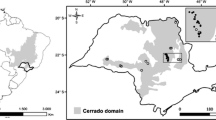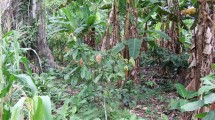Summary
Collections and observations were made in 1963 and 1967 on insects visiting flowers at Hazen Camp and Gilman Camp on Ellesmere Jsland, N. W. T. Canada. The results giving the species of parasitoid Hymenoptera, the flowers visited, and their activity, are shown in this paper (Table 1).
18 species with 50 specimens of 13 genera are listed. Most of them could be found feeding in the nectar of flowers and carrying pollen.
The attractiveness of white blooms to parasitoid wasps, observed in different regions, also holds in the High Arctic, whereStellaria longipes visitors account for 35 in 7 genera out of a total of 41 in 13 genera.
Zusammenfassung
Parasitische Schlupfwespen als Blütenbesucher im kanadischen hohen Norden
Im Sommer 1963 und 1967 wurden im Hazen Camp und Gilmann Camp auf der hochnordischen Ellesmere-Insel Beobachtungen und Sammlungen bezüglich Blüten besuchender Insekten durchgeführt. In der vorliegenden Arbeit sind in Tabelle 1 die gefundenen parasitischen Hymenopteren zusammengestellt.
18 Arten mit 50 Individuen aus 13 Gattungen wurden gefunden, und zwar aus den Familien Chalcididae (3 Arten), Eulophidae (1), Pteromalidae (1), Braconidae (3), Ichneumonidae (9) und undeterm. (1). Am häufigsten war mit 22 Individuen die IchneumonideStenomacrus spec. anStellara-, Saxifraga- undDryas- Blüten vertreten. Es scheint, daß alle Ichneumoniden-Arten Nektar als Betriebsstoff für ihren Flug aufnehmen. Aber auch je eine Chalcididen-, Eulophiden- und Pteromaliden-Art wurden als Nektarfresser festgestellt.
Von jeder beobachteten und anschließend gefangenen Schlupfwespe wird die Tätigkeit an der Pflanze skizziert. Am Körper der meisten Arten fanden sich Pollenkörper. Die in der Literatur aus anderen Gebieten der Erde berichtete besondere Attraktivität weißer Blüten auf parasitische Hymenopteren. wurde auch im Hohen Norden beobachtet: an den weißen Blüten vonStellaria longipes wurden 35 von 41 einzeln registrierten Individuen aus 7 Gattungen angetroffen.
Similar content being viewed by others
Literature
Beutler, R., 1953: Nectar. Bee World.34, 106–116, 128–136, 156–162.
Cooper, K. W., 1952: Records and flower preferences of masarid wasps. II. Polytrophy or oligotrophy inPseudomasaris (Hymenoptera: Vespidae)? Amer. Midland Nat.48, 103–110.
Downes, J. A., 1966: The Lepidoptera of Greenland: some geographic considerations. Can. Ent.98, 1135–1144.
Elton, C., 1966: The pattern of animal communities. Methuen & Co. Ltd. London, 432 pp.
Faegri, K., andL. van Der PIJL, 1971: The Principles of Pollination Ecology. Second Revised Edition Pergamon Press, Oxford, New York, Toronto, Sydney, Braunschweig. XII + 291 pp.
Galil, J., andD. Eisikowitch, 1971: Studies on mutualistic symbiosis betweensyconia andsycophilous wasps in monoecious figs. New Phytol.70, 773–787.
Györfi, J., 1945: Beobachtung über die Ernährung der Schlupfwespenimagines. Erdeszeti Kiserletek45, 110–112, Sopron, Hungary (not consulted).
Györfi, J., 1963: Beiträge zur Biologie und Ökologie der Schlupfwespen (Ichneumonidae), Z. ang. Ent. 50–51, 142–147.
Hassan, E., 1966: Untersuchungen über die Bedeutung der Kraut- und Strauchschicht als Nahrungsquelle für Imagines entomophager Hymenopteren. Diss. Forstl. Fakultät Univ. Göttingen. 134 pp.
Hicks, C. H., 1927:Pseudomasaris vespoides (Cresson), a pollen provisioning wasp. Can. Ent.59, 75–79.
Hocking, B., 1953: The intrinsic range and speed of flight of insects. Trans. R. ent. Soc. ond.104, 223–345.
Hocking, B., 1968: Insect-flower associations in the high arctic with special reference to nectar.Oikos. 19, 359–388.
Imms, A. D., 1964: A general textbook of entomology. Extensively revised by 0. W. Richards and R. G. Davies. Methuen and Co. Ltd., London. 886 pp.
Kevan, P. G., 1970: High arctic insect-flower relations: the inter-relationships of Arthropods and flowers at Lake Hazen, Ellesmere Island, N. W. T., Canada. Unpubl. Ph. D. thesis, Dept. Entom. Univ. Alberta, Edmonton, Canada. XXIII 399 pp.
Kevan, P. G., 1972 a: Insect pollination of high arctic flowers. J. Ecol.60 (3) (in press).
Kevan, P. G., 1972 b: Floral colours in the high arctic with reference to insect-flower relations and pollination. Can. J. Bot. 50 (II) (in press).
King, J. L., andJ. K. Holloway, 1930:Tiphia popilliavora Rohwer, a parasite of the Japanese beetle. U. S. Dept. Agric. Circ. No. 145. 11 pp.
Leius, K., 1960: Attractiveness of different foods and flowers to the adults of some hymenopterous parasites. Can. Ent.92, 369–376.
Müller, H., 1873: Die Befruchtung der Blumen durch Insekten und die gegenseitigen Anpassungen beider. Engelmann, Leipzig. VIII + 478 pp.
Mulligan, G. A., 1972: Autogamy, allogamy and pollination in some Canadian weeds. Can. J. Bot.50, 1761–1771.
Oliver, P. R., 1963: Entomological studies in the Lake Hazen Area, Ellesmere Island, including lists of species of Arachnida, Collembola, and Insecta. Arctic16, 175–180.
van der Pijl, L., andC. Dodson, 1966: Orchid Flowers. Their Pollination and Evolution, University of Miami Press, Coral Gables, Florida.
Richards, 0, W., 1971: The Biology of the Social Wasps (Hymenoptera: Vespidae), Biol. Revs (Cambridge)46, 483–528.
Richards, W. R., 1963: The Aphidae of the Canadian Arctic (Homoptera). Can. Ent.95, 449–464.
Salama, H. S., 1967: Nutritive values and taste sensitivity to carbohydrates for mosquitoes. Mosquito News27, 32–35.
Straw, R. M., 1956 a: Floral isolation inPenstemon. Amer. Nat.90, 47–53.
Straw, R. M., 1956 b: Adaptive morphology of thePenstemon flower. Phytomorphology6, 112–119.
Townes, H., 1958: Some biological characteristics of the Ichneumonidae (Hymenoptera) in relation to biological control. J. Econ. Ent.51, 650–652.
Wigglesworth, V. B., 1965: The principles of insect physiology, (6th Edition). Methuen & Co. Ltd., London. VIII + 741 pp.
Wykes, G. R., 1952: An investigation of the sugars present in the nectar of flowers of various species. New Phytol.51, 210–215.
Zoebelein, G., 1956: Der Honigtau als Nahrung der Insekten. II. Z. angew. Ent.39, 129–167.
Author information
Authors and Affiliations
Additional information
Contribution No. 920,Plant Research Institute of Agriculture, Canada Department, Ottawa, Canada.
Rights and permissions
About this article
Cite this article
Kevan, P.G. Parasitoid Wasps as Flower Visitors in the Canadian High Arctic. Anz. Schadlingskde. Pflanzen-Umweltschutz 46, 3–7 (1973). https://doi.org/10.1007/BF01992960
Issue Date:
DOI: https://doi.org/10.1007/BF01992960




